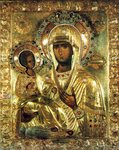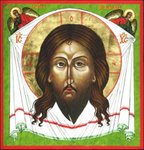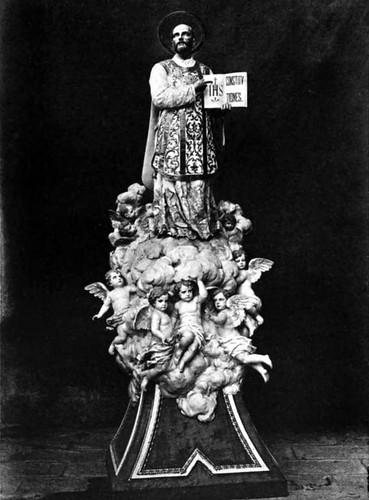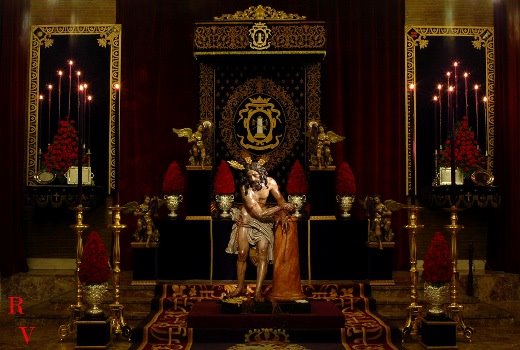Nuestra Señora del Santisimo Rosario de La Naval

“Many an October evening while watching this procession of La Naval, and having divined, by a general excitement, the approach of the image, he has heard the cries and trumpets of the passing concourse. He has seen her blaze into vision against the skies of his city, born upon cloud of incense and music, her face on fire with jewels and mysterious with the veneration of centuries, with gleaming rainbows forming and falling all about her and silken doves bobbing whitely among her flowers of gold and silver -- Oh, beautiful and radiant as an apparition! -- the Presence at Lepanto, Lady and Queen and Mother of Manila, the Virgin of the Fifteen Mysteries.”
- Nick Joaquin
The Feast of La Naval de Manila-- the so-called 'procesion de procesiones'-- is certainly one of the grandest celebrations of Old, and Contemporary, Manila. The story of Lepanto is familiar to all; familiar to us, too, are the stories of the miraculous intercession of the Blessed Virgin, routing the Turkish hosts from Europe and preserving Christendom from destruction. In the Philippines, this story is echoed in the Saga of La Naval-- and how the miraculous Virgin was able to rout a superior Dutch force from the shores of Manila with only a handful of decrepit ships, and a paltry number of Spanish and Filipino forces manning them. This was a feat repeated all of five times, each seemingly more miraculous than the next. And it is for this reason that Nuestra Señora del Santisimo Rosario is hailed as the Queen of the Philippines, her mighty and unfailing champion in times of distress. Over the centuries, jewels and gold and silver and all sorts of precious ornaments and elaborately embroidered dresses have been given to the Virgin. Jewels from visiting royals and medallions from National Artists (Joaquin, notably) have all been laid at the feet of this Grand Lady. In her magnificent, boat-shaped triumphal carriage of silver, La Naval, as she has come to be known in this part of the world, was an imposing-- and majestic-- presence indeed.
Though the intercession of the Virgin of the Rosary has saved this country multiple times in the past, the Great War which wrecked Manila and reduced it into a burnt-out cinder nearly threatened to destroy the image. Ultimately, though, the faith of her devotees persevered, and the savior herself was saved. Here follows an account of the 'rescue' of La Naval from the ruins of the Old Sto. Domingo.
The image of the “Santo Rosario,” along with her regalia — her gold crowns and renowned jewels — along with the other Great Treasures of the Manila Dominicans — the jewel-encrusted gold chalices, monstrances, reliquaries, ecclesiastical accoutrements, silver tabernacles, candlesticks, torcheres, missal stands, banners, ornate ewers and basins, important centuries-old documents, and many other valuables — had been stored by the Spanish Dominicans in their large vault located on the ground floor of the Church Complex. The late Rev. Fr. Augusto Antonio, O.P. described the Santo Domingo Church Vault to Rafael del Casal as having had very thick walls. As The Fire raged for many days and nights, and while the Manila Dominicans prayed for the safety of their Greatest Treasure — the 350 year old miraculous image of the “Santo Rosario” — The Great and Terrible Possibility loomed that the image of the Virgin would not survive the Extreme Heat from The Fire which had completely permeated the vault — and the entire Church Complex as well…
An Eyewitness recounted:
“”In December of 1941, the Japanese warplanes bombed Intramuros. One of the first casualties was the Santo Domingo Church and Convent. The towers were destroyed and only the walls were left. The Church and the Convent burned for many days. Wisely enough, days before the bombings, The Dominican friars had stored the centuries-old image of the “Santo Rosario,” along with her crowns, jewels, and vestments in the “Tesoro del Convento” The Convent Treasury, which faced Plaza Isabel II. But because of the intensity of The Fire, No One really knew if the image of the “Santo Rosario” had survived…”"
THE RESCUE OF THE “SANTO ROSARIO”
But She did, miraculously as always. The Extreme Heat of The Fire had bent, twisted, deformed, and in fact almost melted several of the important gold and silver objects. But the 350 year old [ elephant ] ivory and hardwood image of the ”Santo Rosario” actually survived The Conflagration which had consumed her beautiful, rose-colored, Gothic-style temple from 1875 — the Santo Domingo Church and Convent in Intramuros, a masterpiece by the Europe-trained, patrician architect Don Felix Roxas Sr. — and it also finally laid waste to the historic site of her home beside the Pasig River since 1593.
An Eyewitness recounted:
“”The Prior of the Santo Domingo Church and Convent, Rev. Fr. Aurelio Valbuena, O.P. — a respected and trusted man — decided to transfer the image of the ‘Santo Rosario’ and her crowns, jewels, and vestments to a safer place, to the University of Santo Tomas in Sampaloc District. That was, of course, if She survived…”
“On 30 December 1941, three days before the entry of the Japanese Ground Forces, the Japanese Air Force had started the aerial bombardment of The City. Electricity had been cut off; Blackouts were the norm. Word went around that Massive Looting would take place. Rev. Fr. Aurelio Valbuena, O.P., the Prior of the Santo Domingo Church and Convent, was advised by well-meaning friends and devotees to finally secure the treasures of the Manila Dominicans, paramount of which was the centuries-old ivory image of the “Santo Rosario.”
“And so, on 30 December 1941, at 4:00 p.m., Everyone concerned — the Manila Dominicans, their friends and devotees of the “Santo Rosario,” two Augustinian Recollect priests, and some Manila policemen — got together at The Ruins of the Santo Domingo Church and Convent in Intramuros to see if the ivory image of the ‘Santo Rosario’ had possibly survived The Conflagration within the confines of the “Tesoro del Convento” The Convent Treasury, and if so, to bring her to relative safety at the University of Santo Tomas in Sampaloc…”
“The Vault Door of solid metal was extremely difficult to open. The Group initially thought of blowing it up with a grenade but they found out that it would not be necessary…”
“They decided to use an Acetylene Torch. But The Vault Door resisted to a remarkable degree.”
“Nearly four hours later just before 8:00 p.m., They were still firing away at the mechanism of The Vault Door in Complete Darkness [ Electricity had been cut off; Blackouts had been imposed ]. It was very difficult to open!!!”
“Finally, by 8:00 p.m., They had already succeeded in making a small opening… A few minutes later, the mechanism finally gave way and They were able to force The Vault Door open…”
“The Dominican priests were eager to enter The Vault but an Infernal, Boiling Heat gushed out from it so they had to retreat!!!”
“But from the Vault Entrance, They saw that The Image of the ‘Santo Rosario’ was intact. She had survived!!!”
“Tears of happiness gushed forth as They All immediately knelt down on the wet stone floor of The Convent and prayed the “Salve” aloud. They had never prayed more intently. The Silence, The Blackout, the Faint Moonlight, the Deep Shadows, the Wet Walls… all contributed to the dramatic, almost ‘theatrical’ experience…”
“The Silence was broken by the bursting of canned goods in The Convent ‘Almacen’ Storerooms. All the factors: the Darkness, the Bombings, the Fear, the Assault… all contributed to the Great Emotion of the scene.”"
After the image of the Virgin was retrieved from the smoking vault by the Spanish Dominicans, the Ortigas brothers, their Ramirez-Ortigas nephews, along with some other brave souls, undertook the perilous and heroic task of transporting her secretly, in a rundown “camioneta” truck through the back streets of Sampaloc District, to the Chapel of the University of Santo Tomas, where She remained throughout The War.
“”The image of the ‘Santo Rosario’ was wrapped in a thick blanket. Her image, the wooden chests containing her crowns and her jewels, and the wooden boxes containing her elaborate vestments were all loaded in the same truck.”
“The truck exited through the Colegio de San Juan de Letran side…”
“The silent caravan made its way to the University of Santo Tomas through the dark and deserted streets.”
“The truck was followed by several other cars who escorted the “Santo Rosario” to the University of Santo Tomas.”
“Several people were waiting for the rescuers at the University of Santo Tomas. In fact, there was quite a crowd waiting to receive the ’silent procession’ from Intramuros.”
“Although the ‘Santo Rosario’ was not appropriately dressed, the priests lifted the thick blanket so She could be seen by the assemblage. The crowd knelt reverently and gratefully prayed the “Salve”…
“The Virgin was Saved!!!”
“The next day, some priests returned to the ruins of the Santo Domingo Church, to the “Tesoro del Convento” the Treasury, to retrieve boxes of documents of lesser value, but these had already disappeared in the intervening hours. Had they not retrieved the image of the ‘Santo Rosario’ the previous night, She too, might have disappeared!!!”
“The most important thing is that the historical Virgin is still venerated at the new Santo Domingo Church with the vestments, jewels, and crowns given to her by the Filipino nation.”"
(Source)
Truly a miraculous story. Today, hundreds of years after the Virgin of the Most Holy Rosary saved the Philippines from the Dutch, she still continues to work her miracles. They may not be as grand as before, but they are certainly still as powerful. May she continue to protect this country from certain disaster. Our Lady of the Most Holy Rosary, pray for us.
Click this link to view photos of the procession last Sunday. They are some of the most sublime photos of it that I have ever seen on the internet: La Naval de Manila 2009.

























